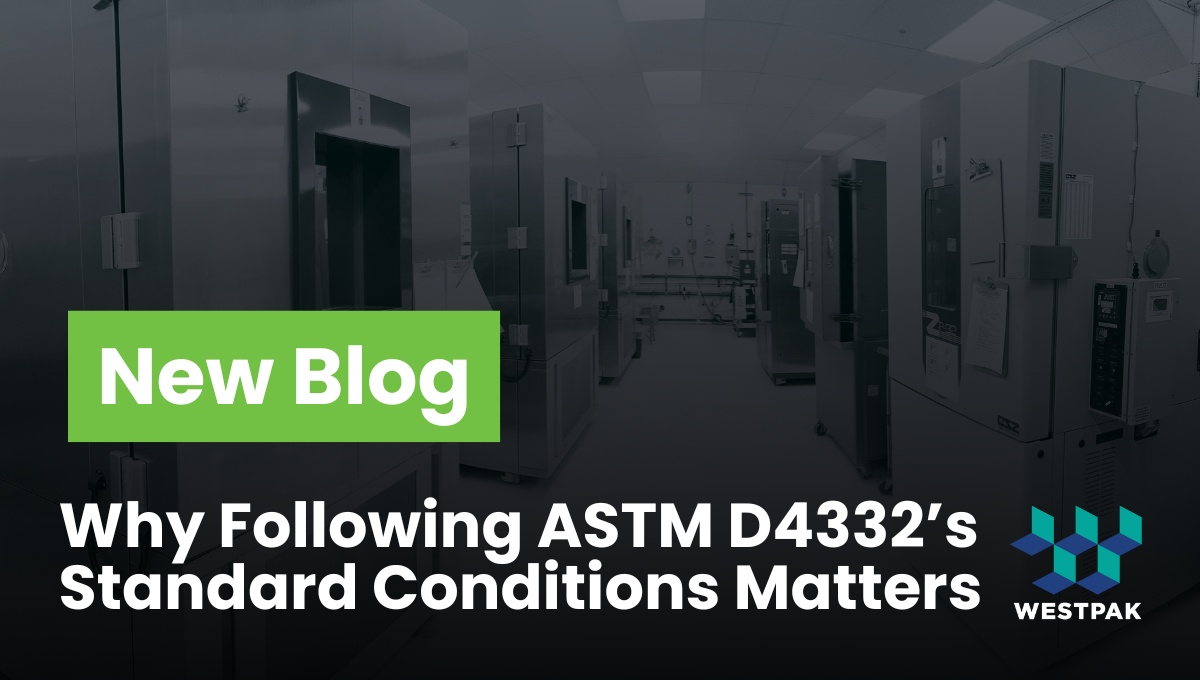When preparing your product and packaging for distribution testing, there’s a critical step that ensures test results actually reflect the real world: environmental conditioning. And that’s where ASTM D4332 comes in.
At WESTPAK, we run ASTM D4332 testing to simulate the environmental extremes your products may encounter during their lifecycle — from manufacturing to transportation and storage.
While the ASTM D4332 standard doesn’t dictate a specific test order or mandate exact one-size-fits-all conditions, we’ve learned from decades of lab operations that consistency and standardization lead to better outcomes with environmental conditioning testing — for both you as the manufacturer and for regulatory bodies like the FDA.
Let’s take a deeper dive into how we apply ASTM D4332 at WESTPAK and what you should know when planning your next round of environmental testing.
What Is ASTM D4332?
ASTM D4332 is the Standard Practice for Conditioning Containers, Packages, or Packaging Components for Testing. In plain terms, ASTM D4332 helps manufacturers evaluate how packaging holds up under environmental conditioning stresses (particularly temperature and humidity) before running physical distribution tests such as drop testing or vibration testing.
It’s a foundational step in test programs for medical devices, consumer electronics, food packaging, and more. And for many of our clients, environmental test standards are where we begin the process of building confidence in your package’s overall performance.
Environmental Conditioning Options under ASTM D4332
ASTM D4332 provides a set of standard environmental conditions that are widely used to simulate the range of temperatures and humidities packages may encounter in real-world distribution. These include:
- Cryogenic: –55°C, uncontrolled humidity
- Extreme Cold: –30°C, uncontrolled humidity
- Frozen Food Storage: –18°C, uncontrolled humidity
- Refrigerated Storage: +5°C, 85% RH
- Temperate High Humidity: +20°C, 90% RH
- Tropical: +40°C, 90% RH
- Desert: +60°C, 15% RH
These environmental conditions are designed to represent a wide spectrum of global environments — from extreme cold chain distribution to tropical or desert climates.
Common Environmental Conditioning Sequences in Practice
While ASTM lists several conditioning environments, in practice we see most customers focusing on three profiles that tend to cover the broadest range of distribution extremes:
- Extreme Cold: –30°C (uncontrolled humidity)
- Tropical (Hot & Humid): +40°C with 90% RH
- Desert (Hot & Dry): +60°C with 15% RH
These conditions are often selected because they reflect some of the harshest exposures packages may face during storage, shipping, and handling across different regions and seasons.
When multiple environmental conditioning steps are applied, customers most frequently run them in this sequence:
- Cold conditioning (–30°C, uncontrolled RH)
- Hot & Humid (+40°C / 90% RH)
- Hot & Dry (+60°C / 15% RH)
This order has become common practice because it provides consistency, supports regulatory defensibility, and allows downstream distribution testing to be performed on packages that have been through a full range of challenging environments.
Duration of ASTM D4332 Environmental Conditioning
ASTM D4332 does not prescribe a fixed duration for conditioning, it calls out:
- “Place the container package within the conditioning chamber and expose it to the required conditions for an amount of time specified in the particular test procedure. “
- “If no time period is specified, a period of at least 72h, or that time required to reach equilibrium (which may be shorter or longer in duration than 72 h), is recommended.”
- We see most of our customers using a duration of, 24 hours
- This duration allows most packages and products to stabilize at the target conditions.
Longer durations may be specified in certain programs to reflect particular distribution environments, for products and packages to reach equilibrium with the temperature, or regulatory requirements. The appropriate length of environmental conditioning depends on test objectives, product type, and applicable standards.
Why Sticking to the ASTM Standard Matters
Now, can you use different environmental profiles or durations? Of course, but it comes at a cost.
If your testing deviates from ASTM-recommended conditions, the burden of justification falls on you. That means more documentation, more back-and-forth, and a greater risk of scrutiny from regulatory bodies like the FDA.
On the other hand, when you follow industry-standard conditions, you’re operating in a framework that’s broadly accepted and easier to defend in your quality and compliance reports.
We’ve found that the majority of our customers stick with the standard — and for good reason. It simplifies the process and improves the reliability of your testing outcomes.
Ready to Get Started with ASTM D4332 Environmental Conditioning Testing?
Environmental conditioning is a vital part of product and packaging validation. When done right, it helps ensure your products arrive intact—no matter the climate, route, or mode of transport. And it all starts with planning the right ASTM D4332 approach.
Have questions? Need help scheduling a test? Our experienced lab team and responsive Sales Department are here to help. Request a quote or reach out directly to get your project moving.
